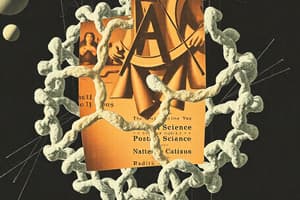Podcast
Questions and Answers
Why was it difficult to perform experiments on atoms with atomic number Z = 60 (Neodymium)?
Why was it difficult to perform experiments on atoms with atomic number Z = 60 (Neodymium)?
- Neodymium cannot be beaten into very thin foils due to its hexagonal close-packed crystal structure (correct)
- Neodymium is too heavy to be accelerated to high energies
- Neodymium atoms are too unstable and radioactive
- Neodymium is too rare and expensive to obtain in large quantities
What was the key finding of the Geiger and Marsden experiments on Rutherford scattering?
What was the key finding of the Geiger and Marsden experiments on Rutherford scattering?
- They discovered that the internal structure of atoms is made up of mostly empty space
- They were able to transform one type of atom into another by bombarding them with alpha particles
- They found that the Rydberg equation accurately predicts the wavelengths of atomic emission spectra
- They observed that a few alpha particles were scattered at backward angles greater than 90° (correct)
What is the significance of the log-log graph in the context of Rutherford scattering experiments?
What is the significance of the log-log graph in the context of Rutherford scattering experiments?
- It enables the experimental rule of only changing one variable at a time
- It demonstrates the quantization of angular momentum in atomic systems
- It shows that relationships of the form y = ax^k appear as straight lines, allowing for the determination of the exponent k (correct)
- It allows for the visualization of the Rydberg equation and Balmer series
What was Rutherford's famous quote about the nature of science?
What was Rutherford's famous quote about the nature of science?
What was Rutherford's key contribution to the understanding of the structure of atoms?
What was Rutherford's key contribution to the understanding of the structure of atoms?
Which of the following is the correct expression for the Rydberg constant $R_\infty$?
Which of the following is the correct expression for the Rydberg constant $R_\infty$?
What is the significance of the Balmer series in the context of the Bohr model of the hydrogen atom?
What is the significance of the Balmer series in the context of the Bohr model of the hydrogen atom?
According to the Bohr model, what is the significance of the quantization of angular momentum in atoms?
According to the Bohr model, what is the significance of the quantization of angular momentum in atoms?
What is the significance of the X-ray spectrum in the context of atomic structure?
What is the significance of the X-ray spectrum in the context of atomic structure?
Which of the following statements about the stability of atoms is correct?
Which of the following statements about the stability of atoms is correct?
Flashcards are hidden until you start studying




